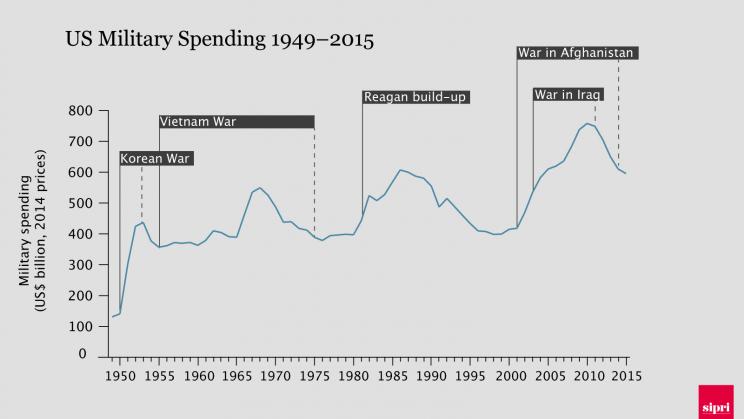
SIPRI is proud to announce the online release of its extended military expenditure data. Previously, the SIPRI Military Expenditure Database covered the period 1988–2015; the extended military expenditure data goes back in most cases at least to the 1960s, and in some cases to 1949.
The new data highlights long-term trends in military spending. In the case of the USA, clear peaks in spending can be seen during the Korean War, the 'Reagan build-up' and the more recent wars in Afghanistan and Iraq. In Western Europe, military spending rose steadily during the cold war, while in Africa, military spending has surged in recent decades as the continent's economies have improved.
Europe and the Americas are the regions with the best data availability. Data for the Soviet Union and China is not available before 1988 due to severe difficulties in producing reliable estimates.
The extended military expenditure data includes military expenditure by country in constant US dollars (2014), current US dollars, local currency for fiscal year and calendar year, and share of GDP. Estimates of world military expenditure are available from 1988–2015, and of regional military spending for varying periods, depending on the availability of national data.
This extended data is the result of years of research for military spending figures and economic data, through historical documents and archives, as well as rigorous analysis of the figures and their sources. This effort was undertaken following frequent requests from researchers and the general public for longer time series for national military expenditure.
Background
SIPRI has been collecting military expenditure data since the late 1960s. The SIPRI Military Expenditure Database was published in the very first SIPRI Yearbook in 1969/70. The current online version was made freely available on the SIPRI website in 2009.
SIPRI seeks to ensure the highest possible level of consistency of data series for each country over time, and compliance with SIPRI’s common definition of military expenditure.
Special thanks
SIPRI offers special thanks to Dr Jennifer Brauner, Elena Deola, Lidwina Gundacker, Dr Julius Heß, Giulia Tamagni and Mehmet Uye, whose extensive work in searching, documenting and helping to analyse SIPRI’s archived sources of military expenditure data has made this new dataset possible.
SIPRI would also like to thank the Swedish Riksbankens Jubileumsfond for the grant that funded the January 2016 expert workshop where preliminary research using the extended data was presented and discussed.